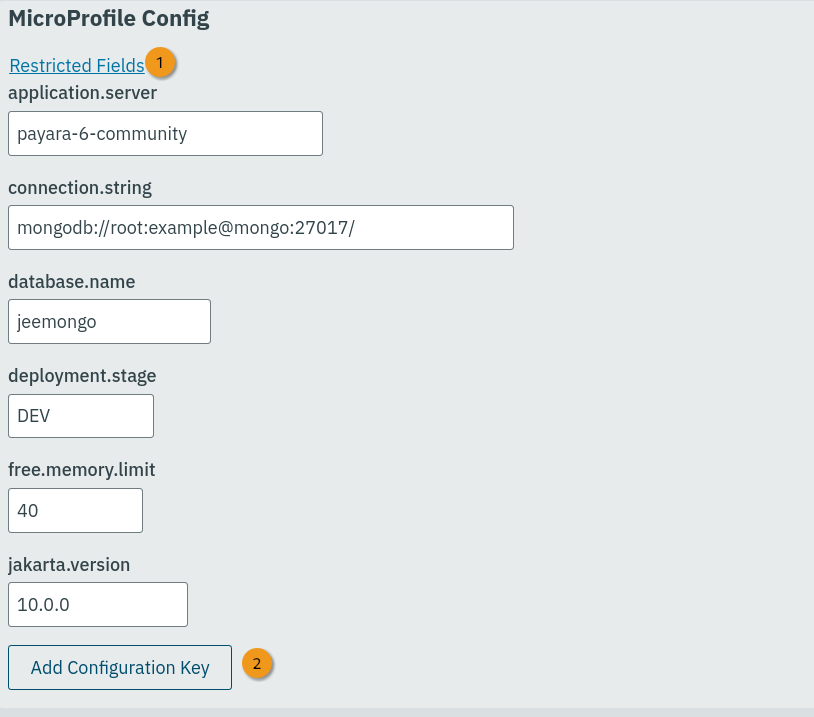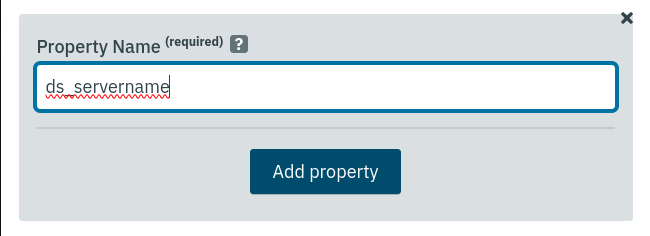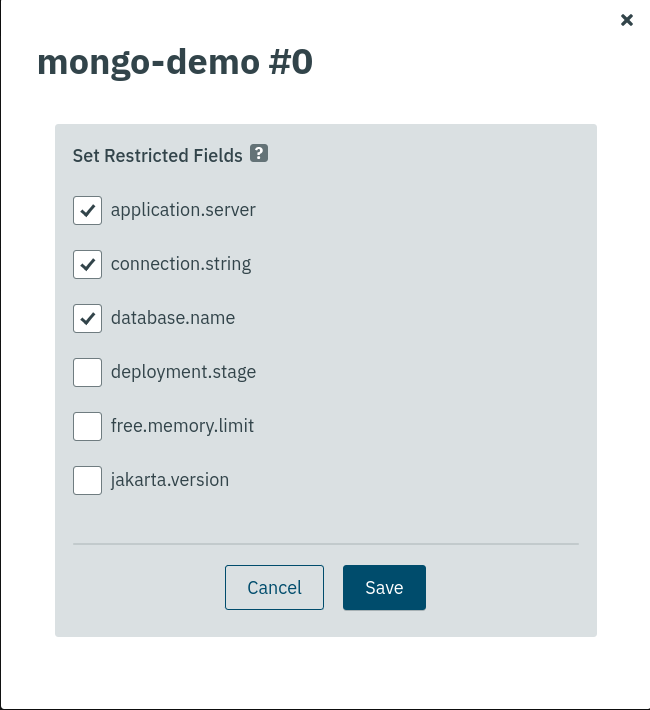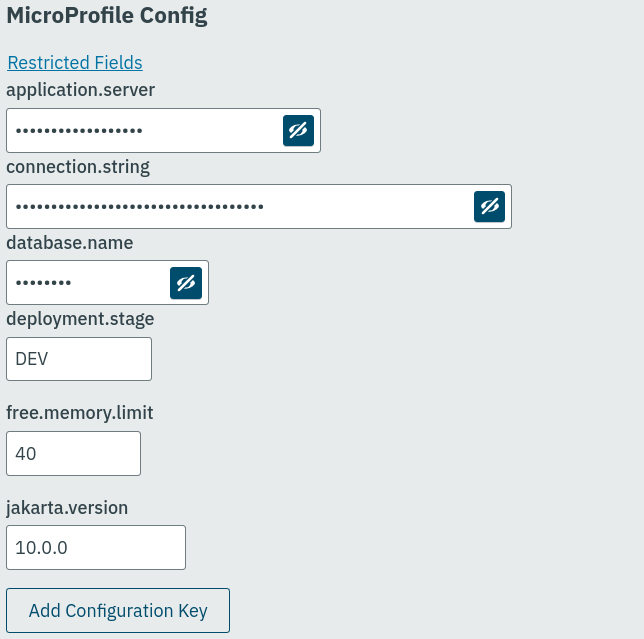Payara Qube (Managed) supports MicroProfile Config, Spring Boot and Quarkus configuration properties, providing an intuitive dashboard for managing all aspects of your application configuration.
For Jakarta EE/MicroProfile applications, configuration properties are managed through MicroProfile Config using the microprofile-config.properties file.
For Spring Boot applications, configuration properties are managed using Spring Boot’s standard application.properties file.
For Quarkus applications, configuration properties are managed using Quarkus’s standard application.properties file.
Configuration Overview
The configuration screen allows you to set up your application before deployment. Payara Qube (Managed) supports configuration for:
-
Configuration Properties - Application-specific settings, such as database connection details or logging levels.
-
Context Root - The URL path where your application is accessible.
The configuration options available depend on your application type:
-
Jakarta EE/MicroProfile applications: Configuration properties from
microprofile-config.propertiesand database settings frompersistence.xml -
Spring Boot applications: Configuration properties from
application.propertiesand Spring datasource configuration -
Quarkus applications: Configuration properties from
application.propertiesormicroprofile-config.properties, and Quarkus datasource configuration
Accessing Application Configuration
To access and modify your application configuration:
-
Click the Application Actions button on your application’s page
-
Select Edit Configuration from the menu
|
When Payara Qube (Managed) detects that configuration is required before deployment (such as when a |
Deployment Configuration
Before deploying your application, configure the deployment settings to ensure your application runs in the correct environment with appropriate resources.
|
Configuration for Runtime Type, Java Runtime, and Runtime Size is optional. If not specified, Payara Qube (Managed) will automatically select appropriate values based on your application artifact. |
App Runtime Configuration
You can select the scaling method and runtime size of your Payara Qube (Managed) application on the application configuration dashboard
-
❶ Scalability Type: There are three scalability types you can choose from for your application.
-
❷ Runtime Type: The underlying combination of Java and Jakarta EE, Spring Boot or Quarkus versions that your application is developed against.
-
❸ Runtime Size: The runtime or "CPU size" that powers your application.
-
❹ Scale Down To Zero: Option to automatically scale down the application to zero instances when idle.
-
❺ Rollover Time: The rollover time for new uploaded application versions to replace the currently deployed version.
Scalability Types
There are three stability types in Payara Qube (Managed). These are Rolling Upgrade, Singleton and Horizontal Scaling.
Rolling Upgrade
This is the default scaling type. A new application version is deployed and the prior one is terminated when the newly deployed version reports its readiness. Payara Qube (Managed) determines the readiness of an application by calling the MicroProfile Health (for Jakarta EE/Java EE and Quarkus apps) and Spring Actuator endpoint if one is bundled with the application. If not then the default health endpoint of the underlying Payara Micro instance is called. Rolling upgrade scalability type can be configured through the Rollover Time.
Singleton
The singleton scalability type allows only one running instance of the application. The current running instance is terminated before a new version is deployed.
| Depending on the speed of your deployment, there may be a brief moment when your application is not accessible as the new version gets deployed. |
Horizontal Scaling
Horizontal scaling allows for configuring up to 8 application replicas. Payara Qube (Managed) will create and destroy the replicas as needed based on application load. You can also enable Data Grid Mode to take advantage of Payara Data Grid for the application.
Runtime Type
Select the runtime that matches your application framework and version:
-
For Jakarta EE 8 applications, select Payara 5, JDK 11
-
For Jakarta EE 10 applications, select Payara 6, JDK 21
-
For Spring Boot applications, select the appropriate Spring Boot runtime option
-
For Quarkus applications, select the appropriate Quarkus runtime option
Runtime Size
The runtime size specifies the amount of resources to allocate for this instance and count against the included vCPU of your subscription. The resource allocation is as follows:
| Runtime Size | vCPU reservation | Heap memory |
|---|---|---|
0.25 vCPU |
0.25 |
400 MB |
0.5 vCPU |
0.50 |
800 MB |
1 vCPU |
1 |
1700 MB |
2 vCPU |
2 |
5800 MB |
4 vCPU |
3.5 |
11900 MB |
Scale Down To Zero
This feature allows your application to automatically scale down to zero instances when idle, reducing resource consumption and costs.
| Setting | Description |
|---|---|
Enable |
After a specified period of time (default of 20 minutes) of no requests to the application, the deployed instance is scaled down to zero. The instance scales up again when a new request arrives. |
Disable |
The application maintains at least one running instance at all times. |
Context Root
The context root defines the URL path where your application is accessible.
For Jakarta EE/MicroProfile applications, the WAR file name is used as the default context root. For Spring Boot applications, use server.servlet.context-path, and for Quarkus applications, use quarkus.http.root-path in your application properties.
The context root can be changed through the Application Configuration screen for all application types.
Internet-Accessible Paths
By default, all paths under your context root (/*) are accessible both within the namespace and over the internet. You can restrict which sub-paths are publicly accessible while keeping them available to other applications within the namespace.
To configure internet-accessible paths, enter space-separated patterns in the form /prefix*. Only paths matching these patterns will be accessible through the namespace’s public domain.
Example:
Context Root: /orders
Internet-Accessible Paths: /details/ /cancel/
Publicly accessible requests:
https://namespace-domain.payara.app/orders/details/000234 https://namespace-domain.payara.app/orders/cancel/00234
Not publicly accessible (returns to root handler):
https://namespace-domain.payara.app/orders/place
Applications within the namespace can still access restricted paths:
http://applicationName/orders/place
|
Communications within a namespace use HTTP only, as traffic is isolated to the namespace. HTTPS is available for inbound traffic from the internet. |
Configuration Properties
You can add, update and remove configuration properties for your application on the configuration panel of the application dashboard. The specific configuration mechanism used depends on your application type:
-
Jakarta EE/MicroProfile applications: Use MicroProfile Config properties
-
Spring Boot applications: Use Spring Boot configuration properties
-
Quarkus applications: Use Quarkus configuration properties
-
❶ Restrict Fields: This option allows you to mark fields as restricted for confidentiality. Values of restricted fields will be represented as * characters
-
❷ Add Config Property: Clicking this button opens up the form to add a new configuration property for your application
Automatic Sensitive Field Detection
During the application upload process, Payara Qube (Managed) performs a best-effort automatic detection and pre-restriction of configuration properties that may contain sensitive information such as API keys, passwords, tokens, and other credentials.
|
This automatic detection is a best-effort process and may not identify all possible sensitive fields in your configuration. Users should review their configuration properties and manually restrict any additional sensitive fields as needed using the field restriction features described below. |
Adding Configuration Properties
For Jakarta EE/MicroProfile, Spring Boot, and Quarkus applications, you can create new properties by clicking the Add Configuration Key.
Configuration properties provide a way to externalize configuration parameters for your application:
-
Jakarta EE/MicroProfile applications: Use MicroProfile Config properties from
microprofile-config.properties. You can inject them using CDI (@ConfigProperty) or retrieve them programmatically. -
Spring Boot applications: Use Spring Boot configuration properties from
application.propertiesorapplication.yml. These can be injected using @Value or @ConfigurationProperties. -
Quarkus applications: Use application properties from
application.properties. You can inject them using @ConfigProperty or access them programmatically.
When you upload your application, Payara Qube (Managed) looks for the appropriate configuration file (microprofile-config.properties for Jakarta EE/MicroProfile, or application.properties for Spring Boot and Quarkus) to read existing configuration parameters.
Your default parameters are read and displayed here, and you can override them or add new configuration keys.
The Add Configuration Key is useful when reading configuration values programmatically or when the values don’t have a default in your configuration files.
|
Configuration properties added through the Payara Qube (Managed) Console are made available to your application at runtime, but they will NOT modify or be written back to your application’s |
Common Quarkus Properties
|
Quarkus distinguishes between different configuration phases that affect when properties can be changed:
To determine which configuration phase a property belongs to, consult the Quarkus Configuration Reference. Properties marked with a lock icon or labeled as "build time" cannot be changed after the application is built. Note that some Quarkus properties may be overridden by the platform to ensure proper operation and integration with Payara Qube (Managed) infrastructure. |
Quarkus applications typically use properties such as:
# Application configuration
quarkus.application.name=my-quarkus-app
quarkus.http.port=8080
# Database configuration (runtime properties only)
quarkus.datasource.username=myuser
quarkus.datasource.password=mypassword
quarkus.datasource.jdbc.url=jdbc:postgresql://localhost:5432/mydb
# Logging configuration
quarkus.log.level=INFO
quarkus.log.category."com.example".level=DEBUGThese runtime properties can be configured through the Payara Qube (Managed) Console when deploying your Quarkus application. Changes to runtime properties require redeployment to take effect. Remember that build-time properties cannot be changed through the Console and require rebuilding your application.
Common Spring Boot Properties
|
Spring Boot does not have explicit build-time vs runtime property types like Quarkus. All Spring Boot configuration properties are read when the application starts. However, properties that initialize infrastructure resources (such as datasources, server ports, or connection pools) require the application to restart for changes to take effect. Properties configured through the Payara Qube (Managed) Console override values in your |
Spring Boot applications typically use properties such as:
# Application configuration (note: server.port and spring.application.name are platform-managed)
spring.profiles.active=production
# Database configuration
spring.datasource.url=jdbc:postgresql://localhost:5432/mydb
spring.datasource.username=myuser
spring.datasource.password=mypassword
# Logging configuration
logging.level.com.example=DEBUG
logging.level.org.springframework.web=INFOThese properties can be configured through the Payara Qube (Managed) Console when deploying your Spring Boot application. Changes to these properties require redeployment to take effect.
Spring Boot Property Limitations
For Spring Boot applications, while you can modify certain properties through the Payara Qube (Managed) Console, any changes to the following system-managed properties will be ignored at runtime. Payara Qube (Managed) hardcodes these values to ensure proper operation and log collection for the Spring application instance:
# Server configuration
server.forward-headers-strategy=NATIVE
server.port=8080
server.servlet.context-path=[auto-determined]
spring.application.name=[auto-determined]
# Management and monitoring
management.health.probes.enabled=true
management.endpoint.prometheus.enabled=true
management.endpoints.web.exposure.include=prometheus,metrics,healthRestricting Fields
You can restrict configuration properties (MicroProfile Config, Spring Boot, and Quarkus properties) by clicking the Restricted Fields link on the configuration panel.
Clicking that button brings up the restrict fields option as shown below.
You can select any number of fields to set as restricted. Clicking save, the restricted fields will be rendered as follows.
Database Configuration
Payara Qube (Managed) supports database connectivity for all application types through their standard datasource mechanisms.
Automatic Database Detection
When you upload your application, Payara Qube (Managed) automatically detects database requirements:
-
Jakarta EE/MicroProfile: Detects
persistence.xmlfiles using the default datasource (java:comp/DefaultDataSource) -
Spring Boot: Detects
spring.datasource.*properties in your configuration -
Quarkus: Detects
quarkus.datasource.*properties in your configuration
When database configuration is detected, Payara Qube (Managed) provides a configuration interface where you can set:
-
JDBC URL: The database connection string
-
Username and Password: Database credentials (optional if included in JDBC URL)
-
Datasource class name: Usually auto-detected from the JDBC URL
Alternative Database Configuration Methods
Jakarta EE/MicroProfile: Databases without JPA
If you are using plain JDBC connections instead of the JPA functionality of Jakarta EE, you can make use of the @DataSourceDefinition:
@DataSourceDefinition(name="java:global/jdbc/cloud-postgres",
className="org.postgresql.ds.PGSimpleDataSource",
serverName = "${MPCONFIG=ds_servername}",
portNumber = 5432,
databaseName = "${MPCONFIG=ds_databasename}",
user="${MPCONFIG=ds_username}",
password="${MPCONFIG=ds_password}"
)Or define the <data-source> element in web.xml:
<data-source>
<name>java:global/jdbc/cloud-mysql</name>
<class-name>com.mysql.jdbc.jdbc2.optional.MysqlDataSource</class-name>
<server-name>${MPCONFIG=ds_servername}</server-name>
<port-number>3306</port-number>
<database-name>${MPCONFIG=ds_databasename}</database-name>
<user>${MPCONFIG=ds_username}</user>
<password>${MPCONFIG=ds_password}</password>
</data-source>combined with MPCONFIG MicroProfile Config variables. These variables can be configured in the Payara Qube (Managed) Console.
Using the MicroProfile Config property MPCONFIG, you can externalize the various properties needed for the connection. This allows you to set different values for different environments and namespaces in Payara Qube (Managed).
Multiple Datasources
You can also use the @DataSourceDefinitions() to define different datasources to connect to different databases:
@DataSourceDefinitions(
value = {
@DataSourceDefinition(name="java:app/jdbc/cloud-postgres",
className="org.postgresql.ds.PGSimpleDataSource",
serverName = "${MPCONFIG=ds_servername}",
portNumber = 5432,
databaseName = "${MPCONFIG=ds_databasename}",
user="${MPCONFIG=ds_username}",
password="${MPCONFIG=ds_password}"
),
@DataSourceDefinition(name = "java:comp/env/DS2",
minPoolSize = 0,
initialPoolSize = 0,
className = "org.apache.derby.jdbc.ClientDataSource",
portNumber = 1527,
serverName = "localhost",
user = "examples",
password = "examples",
databaseName = "examplesDB",
properties={"create=true", "weblogic.TestTableName=SQL SELECT 1 FROM SYS.SYSTABLES"}
)
}
)|
If you are using plain JDBC connections instead of the JPA functionality of Jakarta EE, you need to define the MicroProfile configuration keys manually in Payara Qube (Managed) so the system can detect them as described above. Click 'Add Configuration Key' and enter the property value. In both cases, make sure the appropriate database driver is included in the WAR file you deploy. |
Spring Boot: Database Configuration
For Spring Boot applications, database configuration is typically done through standard Spring Boot properties:
# PostgreSQL example
spring.datasource.url=jdbc:postgresql://localhost:5432/mydb
spring.datasource.username=myuser
spring.datasource.password=mypassword
spring.datasource.driver-class-name=org.postgresql.Driver
# MySQL example
spring.datasource.url=jdbc:mysql://localhost:3306/mydb
spring.datasource.username=myuser
spring.datasource.password=mypassword
spring.datasource.driver-class-name=com.mysql.cj.jdbc.Driver
# Connection pool settings (optional)
spring.datasource.hikari.maximum-pool-size=10
spring.datasource.hikari.minimum-idle=5
spring.datasource.hikari.connection-timeout=20000These properties can be configured through the Payara Qube (Managed) application properties interface, allowing you to set database connection parameters without modifying your application code. Make sure the appropriate database driver dependency is included in your Spring Boot application.
Using Environment Variables
You can externalize database configuration using environment variables:
spring.datasource.url=${DATABASE_URL:jdbc:h2:mem:testdb}
spring.datasource.username=${DATABASE_USERNAME:sa}
spring.datasource.password=${DATABASE_PASSWORD:}Multiple Datasources
For applications requiring multiple database connections:
# Primary datasource
spring.datasource.primary.url=jdbc:postgresql://localhost:5432/primary_db
spring.datasource.primary.username=primary_user
spring.datasource.primary.password=primary_password
# Secondary datasource
spring.datasource.secondary.url=jdbc:mysql://localhost:3306/secondary_db
spring.datasource.secondary.username=secondary_user
spring.datasource.secondary.password=secondary_passwordQuarkus: Database Configuration
For Quarkus applications, database configuration is done through Quarkus-specific properties:
# PostgreSQL example
quarkus.datasource.db-kind=postgresql
quarkus.datasource.username=myuser
quarkus.datasource.password=mypassword
quarkus.datasource.jdbc.url=jdbc:postgresql://localhost:5432/mydb
# MySQL example
quarkus.datasource.db-kind=mysql
quarkus.datasource.username=myuser
quarkus.datasource.password=mypassword
quarkus.datasource.jdbc.url=jdbc:mysql://localhost:3306/mydb
# Connection pool settings (optional)
quarkus.datasource.jdbc.max-size=10
quarkus.datasource.jdbc.min-size=5|
Note that The runtime properties ( |
Make sure the appropriate database driver dependency is included in your Quarkus application’s pom.xml or build.gradle file (e.g., quarkus-jdbc-postgresql or quarkus-jdbc-mysql).
Using Environment Variables
You can externalize database configuration using environment variables:
quarkus.datasource.jdbc.url=${DATABASE_URL:jdbc:h2:mem:testdb}
quarkus.datasource.username=${DATABASE_USERNAME:sa}
quarkus.datasource.password=${DATABASE_PASSWORD:}Multiple Datasources
For applications requiring multiple database connections:
# Default datasource
quarkus.datasource.db-kind=postgresql
quarkus.datasource.jdbc.url=jdbc:postgresql://localhost:5432/primary_db
quarkus.datasource.username=primary_user
quarkus.datasource.password=primary_password
# Named datasource
quarkus.datasource.secondary.db-kind=mysql
quarkus.datasource.secondary.jdbc.url=jdbc:mysql://localhost:3306/secondary_db
quarkus.datasource.secondary.username=secondary_user
quarkus.datasource.secondary.password=secondary_passwordAllowing Access to your Database from Payara Qube (Managed)
If you’d like to provision a database for the best possible performance, it is recommended to provision it on Microsoft Azure in the same region as the namespace.
If your database access is restricted by IP address, enable access to the following IP addresses based on the region the namespace is located in:
| Region | IP Address(es) |
|---|---|
Azure, West Europe |
20.101.201.13 |
Azure, East US |
40.76.131.181 |
When you are happy with your configuration settings, click Save to return to the application details screen.








